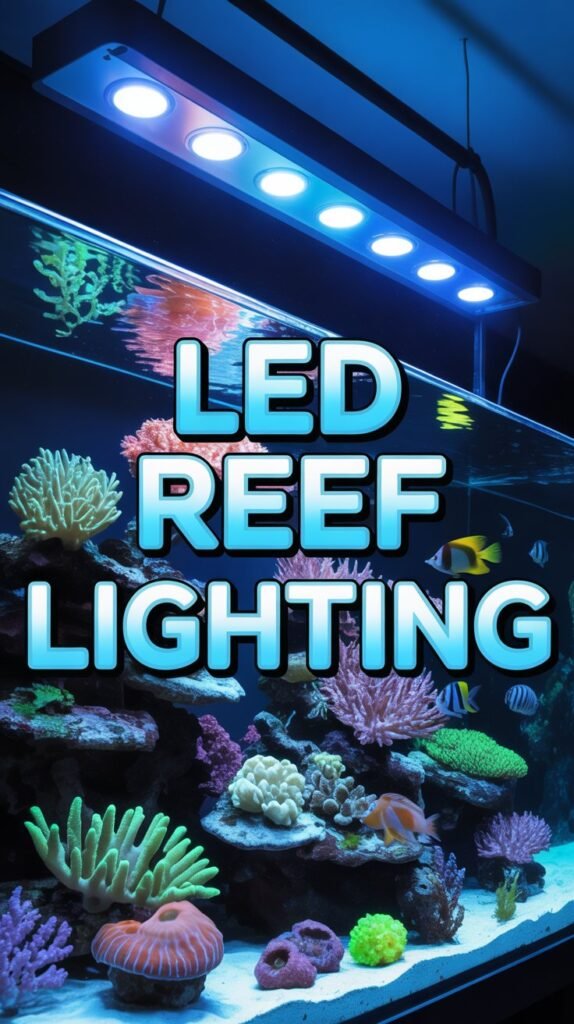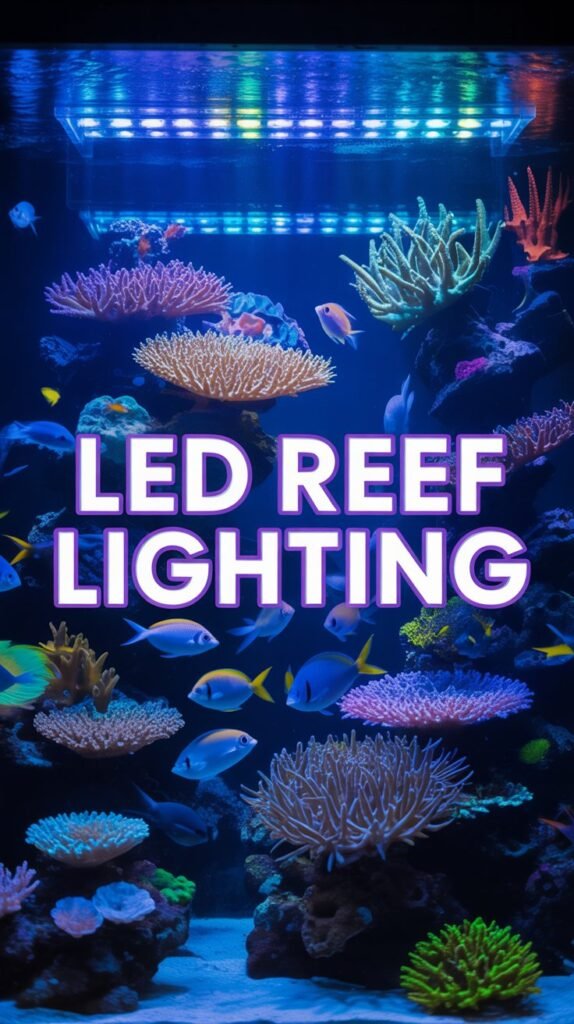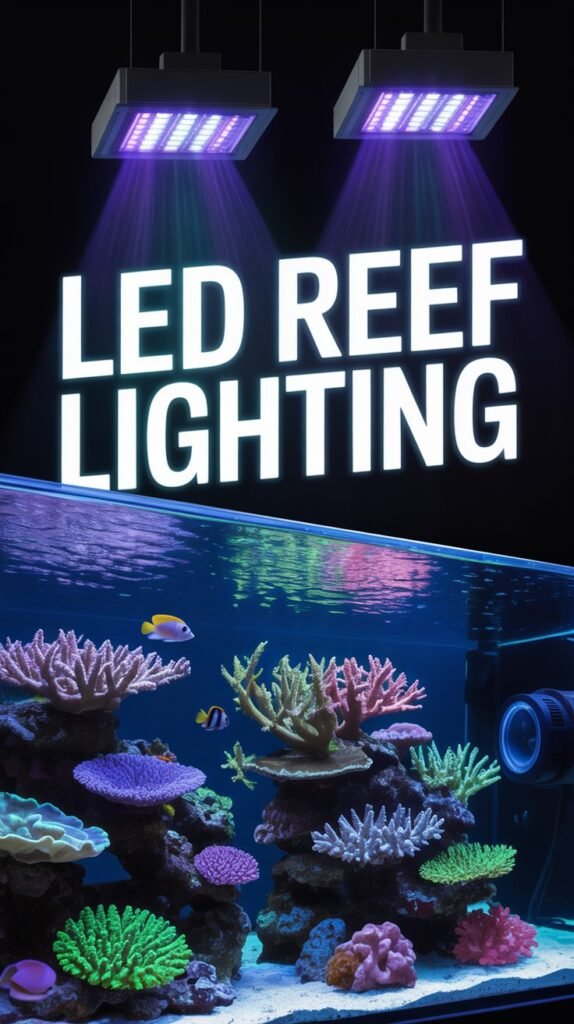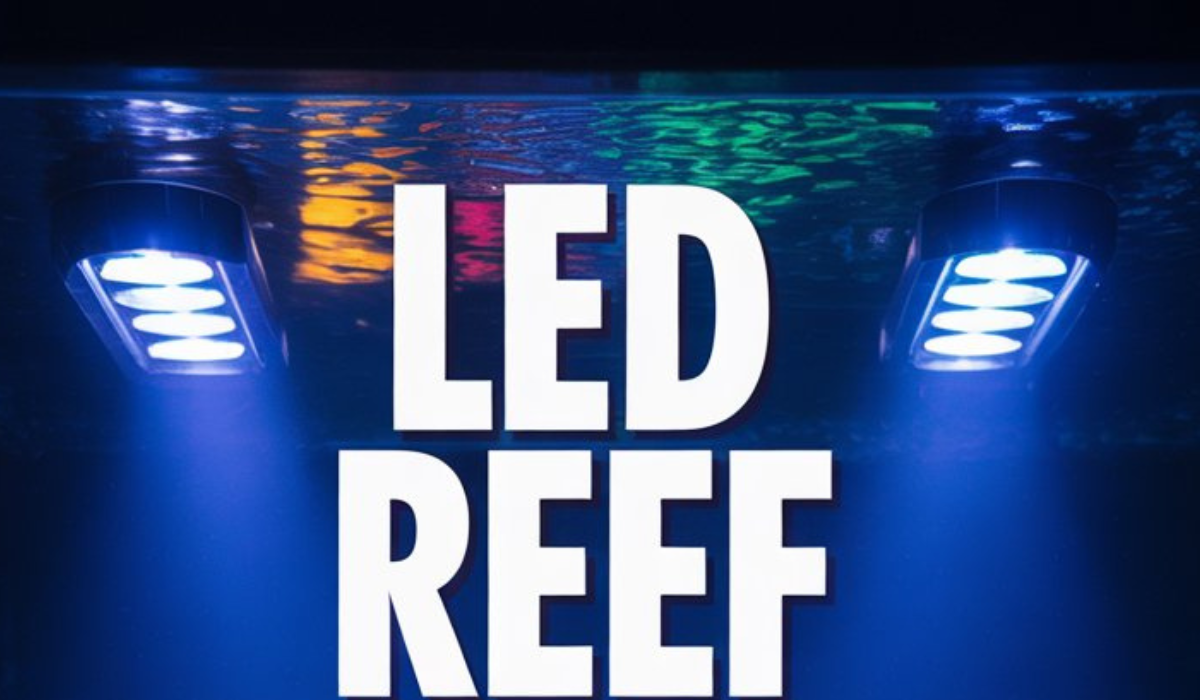Lighting is one of the most critical components of a successful reef aquarium. It doesn’t just make your tank look beautiful — it also directly affects coral health, coloration, and growth. Among all lighting options available to reef hobbyists today, LED reef lighting stands out as the most advanced, energy-efficient, and customizable solution.
In this comprehensive guide, we’ll cover everything you need to know about LED reef lighting — how it works, why it’s important, how to choose the right setup, and tips for getting the most out of it. Whether you’re a beginner aquarist or an experienced reef keeper, this article will help you make informed lighting decisions for your corals and marine life.
What Is LED Reef Lighting?
LED reef lighting refers to the use of Light Emitting Diodes (LEDs) as the primary light source in saltwater reef aquariums. LEDs produce light by passing an electrical current through a semiconductor, which emits photons. Unlike traditional fluorescent or metal halide bulbs, LEDs are compact, energy-efficient, and capable of producing a precise range of wavelengths.

In reef aquariums, the light spectrum is vital because corals depend on photosynthetic algae called zooxanthellae for nutrition. These algae require specific light wavelengths — mainly blue and violet — to photosynthesize effectively. Modern LED reef systems are designed to replicate natural sunlight in the ocean, providing the exact spectrum needed for coral growth and color enhancement.
Why LED Lighting Is Popular in Reef Aquariums
Over the past decade, LED reef lighting has become the industry standard — and for good reason. Let’s look at why aquarists around the world are switching to LEDs.
1. Energy Efficiency
LEDs use significantly less electricity than traditional lighting systems like T5 fluorescents or metal halides. They convert most of their energy into light instead of heat, which reduces your power bills and keeps tank temperatures stable.
2. Customizable Spectrum
Most LED fixtures allow you to adjust the color spectrum — from cool blues to warm whites — to match the needs of your specific coral species. This customization helps maximize coral growth and enhance visual appeal.
3. Long Lifespan
High-quality LED reef lights can last up to 50,000 hours, meaning years of use before any replacements are needed. This longevity makes them a smart long-term investment.
4. Cool Operation
Unlike metal halide lights that can heat up your aquarium, LEDs produce minimal heat. This helps maintain ideal water temperatures and reduces the need for additional cooling equipment.
5. Dimmable and Programmable
LED reef lighting systems can be programmed to simulate natural daylight cycles — sunrise, midday, sunset, and even moonlight. This gradual light transition helps reduce coral stress and enhances your viewing experience.
6. Vivid Coral Coloration
LEDs produce high PAR (Photosynthetically Active Radiation) output and allow fine-tuning of color channels. As a result, corals display more vibrant hues under LED lighting, from deep blues to fluorescent greens and reds.
How LED Reef Lighting Works
LED lights emit light when an electric current passes through semiconductor diodes. In reef fixtures, multiple LEDs are grouped together to create a balanced, full-spectrum light suitable for coral photosynthesis.
Most reef-grade LED fixtures include different colored diodes, such as:
- Royal Blue (450–460 nm) – Crucial for coral fluorescence and photosynthesis.
- Cool White (10,000–12,000K) – Provides brightness and natural appearance.
- UV/Violet (400–420 nm) – Enhances pigmentation and coral coloration.
- Red and Green LEDs – Adjust the overall tone and enhance specific coral hues.
Advanced fixtures use lenses and optics to focus light deeper into the aquarium, ensuring even coverage from the water surface to the bottom.
Benefits of Using LED Reef Lighting

Here’s why LED reef lighting is often considered the gold standard for modern reef aquariums:
1. Superior Energy Efficiency
LEDs consume up to 60–80% less power than traditional lighting systems, reducing electricity costs while delivering high PAR output.
2. Precise Spectrum Control
You can adjust the intensity and color spectrum of individual channels, allowing you to fine-tune lighting for coral growth and color enhancement.
3. Reduced Maintenance
No more replacing bulbs every 6–12 months. LEDs have long lifespans and require minimal upkeep, making them cost-effective and hassle-free.
4. Programmable Light Cycles
With built-in controllers or smartphone apps, you can simulate natural light patterns, which help stabilize coral circadian rhythms and promote health.
5. Less Heat Transfer
Because LEDs produce less heat, they help maintain stable tank temperatures, which is crucial for sensitive reef species.
6. Compact and Sleek Design
LED fixtures are lightweight, easy to mount, and visually appealing, enhancing your aquarium’s aesthetics without bulky equipment.
Choosing the Right LED Reef Lighting System
Selecting the best LED reef light for your aquarium depends on your tank size, coral type, and budget. Here’s what to consider:
1. Tank Size and Depth
Light intensity decreases as it penetrates water. Shallow tanks (under 18 inches) can use lower-powered LEDs, while deeper tanks require stronger fixtures with high PAR output.
2. Coral Type
- Soft corals and LPS (Large Polyp Stony) corals: Moderate light intensity (100–150 PAR).
- SPS (Small Polyp Stony) corals and clams: High light intensity (200–400 PAR).
3. Coverage Area
Ensure the fixture covers your entire tank evenly. Some LEDs focus light narrowly; others use wide-angle optics for better spread.
4. PAR and Spectrum Output
Look for fixtures that provide balanced PAR (Photosynthetically Active Radiation) levels between 100–400 µmol/m²/s, depending on your coral species.
5. Control Features
Modern LEDs offer:
- Wi-Fi or Bluetooth control
- Dimming functions
- Custom light schedules
- Cloud and lightning simulations
6. Brand Reputation
Reputable LED reef lighting brands include:
- EcoTech Marine (Radion series)
- AI (AquaIllumination Hydra, Prime, and Nero)
- Kessil (A360X, AP9X)
- Red Sea ReefLED
- Noo-Psyche and Nicrew (budget-friendly options)
LED Reef Lighting Setup Guide
Installing your LED reef lighting correctly ensures even coverage and optimal coral performance.
Step 1: Mounting
Position the fixture 8–12 inches above the water surface to provide a good balance of intensity and spread. Use mounting arms, hanging kits, or canopy mounts as needed.
Step 2: Programming
Start with a gradual ramp-up and ramp-down cycle. For example:
- Sunrise: 8:00 AM – 10:00 AM
- Peak light: 10:00 AM – 6:00 PM
- Sunset: 6:00 PM – 8:00 PM
- Moonlight: 8:00 PM – Midnight
Step 3: Adjusting Spectrum
Use more blue and violet light for coral health and less white to reduce algae growth. Start with moderate intensity (50–60%) and increase slowly as corals acclimate.
Step 4: Testing PAR Levels
Use a PAR meter to measure light intensity at various depths. Adjust fixture height or settings to maintain optimal levels for your coral species.
Best Spectrum for Reef Aquariums

The ideal light spectrum for reef aquariums should closely match the natural light conditions found in tropical reefs. Corals absorb light primarily in the blue and violet range (400–480 nm) for photosynthesis.
Here’s a general recommendation:
- Royal Blue: 40–50%
- Blue: 20–30%
- White: 15–20%
- UV/Violet: 5–10%
- Red/Green: Minimal (used to enhance visual appearance)
This combination enhances coral fluorescence and coloration while maintaining natural aesthetics.
LED Reef Lighting vs. T5 and Metal Halide
| Feature | LED Reef Lighting | T5 Fluorescent | Metal Halide |
|---|---|---|---|
| Energy Efficiency | Very high | Moderate | Low |
| Heat Output | Minimal | Moderate | High |
| Spectrum Control | Fully adjustable | Fixed bulbs | Limited |
| Lifespan | 40,000–50,000 hrs | 9–12 months | 6–12 months |
| Cost | High upfront, low maintenance | Affordable | Expensive to maintain |
| Coral Growth | Excellent (tunable) | Excellent | Excellent |
| Aesthetic Appeal | Strong shimmer, vivid colors | Soft uniform light | Intense bright light |
Conclusion:
LEDs combine the best of all worlds — energy savings, long life, precise control, and stunning coral coloration. They’ve become the preferred lighting system for most reef hobbyists.
How to Maintain LED Reef Lighting
Proper care extends the life and performance of your LED reef lights:
- Clean the Lenses and Fixture Regularly
Wipe salt creep and dust with a soft, damp cloth to maintain light clarity. - Check for Overheating
Ensure cooling fans or heat sinks are functioning properly. - Firmware Updates
For smart LEDs, keep software up to date for optimal performance. - Avoid Excess Moisture
Use splash guards and maintain proper ventilation to prevent corrosion. - Monitor Coral Response
Watch coral color and polyp extension — they indicate whether lighting conditions are optimal.
Tips for Getting the Most Out of LED Reef Lighting
- Acclimate corals gradually when switching to LEDs to prevent light shock.
- Use a PAR meter to ensure even lighting across the tank.
- Simulate natural light cycles to promote coral health.
- Avoid excessive white light, as it can promote algae growth.
- Pair with good water parameters (calcium, alkalinity, magnesium) for best coral response.
Energy Efficiency and Cost Savings
One of the greatest advantages of LED reef lighting is energy efficiency. A high-end 100-watt LED fixture can replace a 250-watt metal halide while delivering similar or better PAR output.
Estimated Costs:
- Initial setup: $200–$1000 (depending on brand)
- Monthly electricity cost: $5–$10 (depending on usage)
- Maintenance: Minimal (no bulb replacement for years)
Over time, LEDs save money through lower power consumption and reduced maintenance costs, making them ideal for both hobbyists and professionals.
Common Myths About LED Reef Lighting
Myth 1: LEDs Can’t Grow SPS Corals
False — modern LED fixtures deliver high PAR and full-spectrum output capable of supporting even demanding SPS corals.
Myth 2: LEDs Cause Coral Bleaching
Only if intensity is set too high too quickly. Gradual acclimation prevents bleaching and helps corals adjust.
Myth 3: Blue Light Causes Algae Growth
Algae primarily respond to white and red light, not blue. In fact, blue-heavy spectrums are beneficial for corals.
Myth 4: LEDs Are Too Expensive
While initial cost is higher, the long-term savings on energy and bulb replacement make LEDs cost-effective.
Environmental Benefits of LED Reef Lighting
LED technology is eco-friendly. It uses less electricity, reduces CO₂ emissions, and eliminates the hazardous mercury found in fluorescent bulbs. Additionally, their long lifespan means fewer fixtures end up in landfills, making LEDs a sustainable choice for environmentally conscious aquarists.
Conclusion
LED reef lighting represents the future of reef aquarium illumination. With unmatched efficiency, programmability, and spectral control, LEDs empower hobbyists to create stunning underwater ecosystems that mimic the beauty of natural coral reefs.
From vivid coral coloration to stable water temperatures, LED lights offer numerous advantages that enhance both aesthetics and coral health. Whether you’re running a nano reef or a large SPS-dominated tank, investing in a quality LED reef light is one of the best decisions you can make for your aquatic ecosystem.
FAQs About LED Reef Lighting
1. How long do LED reef lights last?
High-quality LED fixtures last between 40,000–50,000 hours, or around 5–10 years of regular use.
2. Can LED lights grow SPS and LPS corals?
Yes. Modern LED reef systems provide the right PAR and spectrum to support all coral types, including SPS, LPS, and soft corals.
3. How far should LED lights be from the water surface?
Mount LEDs about 8–12 inches above the water for optimal light spread and intensity.
4. Do LEDs cause coral bleaching?
Only if intensity is increased too quickly. Always acclimate corals gradually to new lighting setups.
5. Are LED reef lights energy-efficient?
Yes, LEDs consume up to 80% less energy than metal halides or fluorescent lights.
6. What spectrum is best for coral growth?
A spectrum heavy in blue and violet (400–480 nm) supports coral photosynthesis and enhances coloration.
7. Can I control LED reef lights with my phone?
Many modern fixtures, like AI Hydra and EcoTech Radion, offer app-based Wi-Fi control for easy customization.
8. Do LED reef lights need maintenance?
Minimal — just clean the lenses regularly and ensure fans or heat sinks work properly.
9. Can I mix LED with T5 lights?
Yes, hybrid setups are popular for combining LED shimmer with T5’s even coverage.
10. Are LED reef lights worth the cost?
Absolutely. Their efficiency, longevity, and coral performance make LEDs a long-term, cost-effective investment for any reef keeper.

